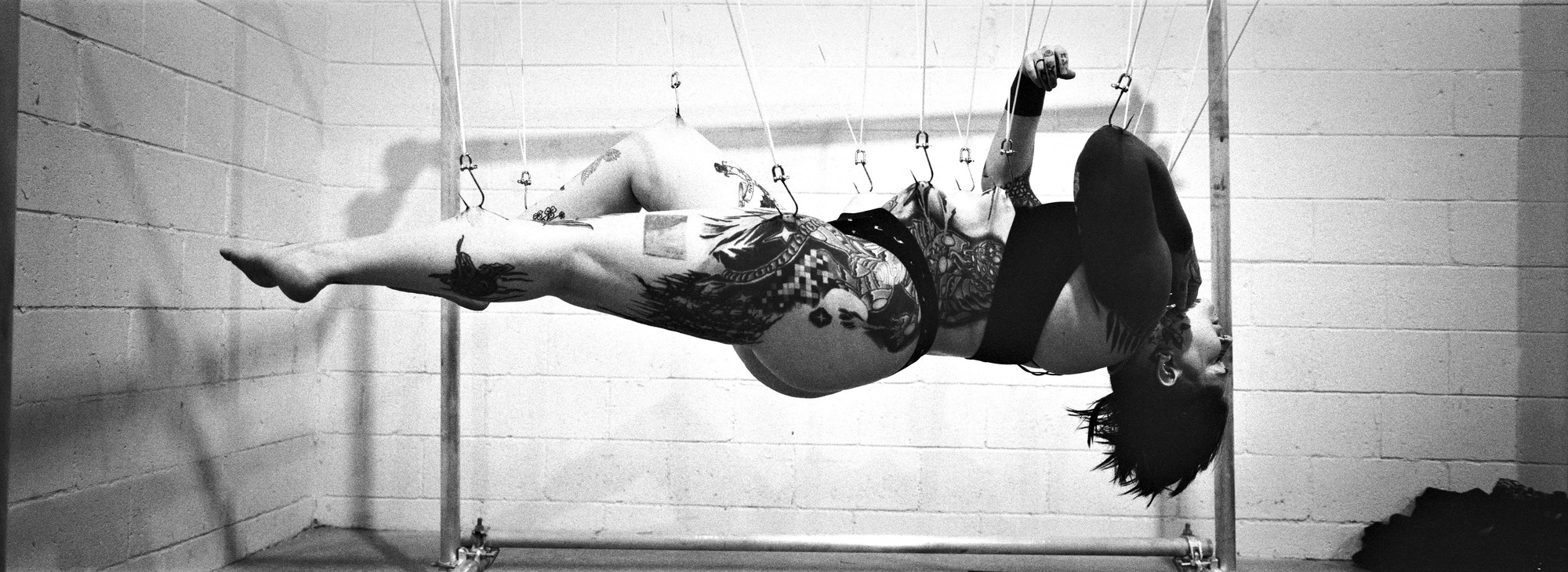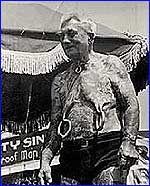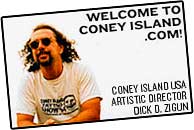
Go to prison, get a free tattoo. Ohhhh… Canada?
|
Category: Features
-
Go to prison, get a free tattoo. [The Publisher’s Ring]
Written by
-
The Great Nippulini Interview – Through the Modified Looking Glass
Written by

The Great Nippulini
“It’s not the load that breaks you down, it’s the way you carry it.”
– Lena Horne
Two of the main focuses of my life and work are body modification and sideshow. I spend time every day researching online for new information, going over the books in my personal library, and generally contemplating and updating my information base on both these subjects. Thus, it surprises when I find out I have somehow missed or overlooked a major player in either of these communities. Nippulini stands out in both, but still I somehow managed to miss him for a number of years.A little less than two years ago was the first time I ever heard of Nippulini — via online references and then his postings in an online sideshow discussion group. Since then I have gotten to meet and even share a stage with him at the 2ND annual Sideshow Gathering. He has made a serious dedication of himself to body modification and taken it to the stage with a rare passion.
Now, in his own words; The Great Nippulini!




Be sure to check out Nippulini’s website at: http://www.greatnippulini.com/
 Erik Sprague
Erik Sprague
because the world NEEDS freaks…
Former doctoral candidate and philosophy degree holder Erik Sprague, the Lizardman (iam), is known around the world for his amazing transformation from man to lizard as well as his modern sideshow performance art. Need I say more?
Copyright © 2004 BMEzine.com LLC. Requests to republish must be confirmed in writing. For bibliographical purposes this article was first published April 26th, 2004 by BMEzine.com LLC in Toronto, Ontario, Canada.
-
Employment Discrimination: Be Careful What You Sue For [Guest Column]
Written by

Employment Discrimination:
Be Careful What You Sue For
By Marisa Kakoulas
On my first day of work at a stereotypical Wall Street law firm, four other lawyers took me for a fancy lunch to welcome me into the fold. All of us in dark suits and pasty white faces politely conversed about acceptable topics, all the while making sure we were using the right fork, until the moment when a man with neon hair, neck tattoos, and multiple facial piercings flashed before the window next to where we sat. The forks dropped. The man outside walked on. But his presence still lingered at our table.
“I don’t understand these freaks with all the tattoos and piercings,” started one at our table, and the discussion spiraled onwards towards burning the modified at the stake. Fortunately for me, my piercings and tattoos at the time were easily covered, otherwise I would’ve gotten singed.
…Or fired.
“A person can be fired because the company doesn’t like your shoes,” explains Robert D. Lipman, who manages the New York employment firm Lipman & Plesur, LLP, and is President of Interactive Employment Training, Inc.. I called Lipman to ask whether a person fired solely for having visible tattoos or piercings has any recourse under United States law. “We get a lot of calls like this,” he said. “People say ‘This is America. We should be able to do what we want.’ But I tell them that once you walk into a private employers workplace, your rights are limited.”
Limited, but not null.
Title VII of the US Civil Rights Act of 1964 says that a private company with more than fifteen employees cannot discriminate on the basis of religion, sex, race, color, or national origin. So company decisions to hire, fire, promote, shell out benefits or the key to the Executive Washroom must not be based on these “protected classifications.” To do so is illegal. Title VII is not the only law that protects Americans from job discrimination. Many state laws have extended protection against discrimination on the basis of sexual orientation, transgenderism, and even obesity. There’s also the federal Americans with Disabilities Act, Equal Pay Act, Age Discrimination in Employment Act, Immigration Reform and Control Act, Pregnancy Discrimination Act, and the National Labor Relations Act.
Despite all these Acts, the curtain falls for those judged on their body modifications, no matter how good the performance. That is, unless you can make a claim under one of these classifications.
RELIGIOUS DISCRIMINATION

While employees generally have more success claiming that dress codes infringe upon religious beliefs, for the tattooed and pierced, success is unlikely.
But isn’t body modification a choice like religion?
“Absolutely, yes. But the Constitution specifically guarantees religious protection,” says California and New York licensed attorney John Thomure, who has represented pro-bono petitioners before the US Supreme Court on constitutional protection claims, as well as having contributed to amicus briefs challenging South Carolina’s ban on tattooing. Heavily tattooed himself, Thomure says:
“Although we might grant great spiritual significance to our own body mods, my sense is a court would cast a very skeptical eye on it as a religious practice. And since outside of perhaps indigenous cultures [...] there is no history or antecedents for the “religion,” it would certainly look as though the creation of the body-mod religion was for the purpose in part of creating legal claims under a freedom of religion argument.”
Case in point: The Church of Body Modification [uscobm.com]. The Church states on its web site that its purpose is “for our modified society to harmoniously return to its spiritual roots that have been forgotten.” It adds that “we are not here to offer spirituality to you so much as we are here because of the spirituality that is already in all of us; often expressed through what we do to our bodies.”
This may not cut it as “a bonafide church.” Lipman mentions a California 9th Circuit Court of Appeals case where a vegan filed a discrimination suit under religious classification. The Court rejected the veganism as a religion claim, holding that vegan ethics do not constitute a religious creed because (among others) it is not a comprehensive belief system that addresses “fundamental and ultimate questions having to do with deep and imponderable matters.” Moreover, it noted that some people were vegan for health and not spiritual reasons.
It is very clear that the Church of Body Modification does not offer an answer to that ultimate question: “Why are we here?” And it does state on its site that many people choose to modify their bodies for non-spiritual reasons. Nevertheless, that did not stop one 27-year old woman from filing suit against Costco claiming that, as a member of the Church of Body Modification, her eyebrow piercing was an essential part of her faith. The case is still pending [questions forwarded to her went unanswered], and while unlikely, if it succeeds it could set major precedent in employment law.
Don’t get your hopes up. As Thomure points out, “Think of Mormons […] their practice of polyamory has not been given protection because of a conflict with a larger public policy.”
Public policy is key here because even if the Church of Body Modification could be deemed a bonafide religion, is it reasonable to ask a company like Costco to potentially lose customers who are put off by visible mods, especially more extreme ones? Jewish yarmulkes, beards, and religious garbs are acceptable. Can we claim full-body lizard scales in the same category? And while performer and PhD candidate Erik “The Lizardman” Sprague is probably smarter than all of us, should Costco be forced to have him ring up bulk items for Brooklyn grandmothers (assuming that’s a dream of Erik’s)?
I say no, unless lizard scale tattoos are allowed on female employees but not male, which brings us to…
SEX DISCRIMINATION

If an employer’s dress code significantly differentiates between men and women, without being based on social norms, or poses a greater burden on women, then it can be deemed discriminatory. So, for example, a dress code that allows earrings for women but not men could be considered discriminatory.
Imagine a case where a company allows its male employees to sport visible tattoos, but, after reading in the Philadelphia Daily News that tattooed women are sluts, the employer decides that it’s best for public relations that female workers remain pure and unblemished: To that, one can hear a resounding “Sue their ass!”
Keep in mind that the US courts have often held that anti-discrimination laws are not intended to hinder employers who set reasonable appearance standards fitting for their business. In 1998, the 11th Circuit Court of Appeals in Harper v. Blockbuster Entertainment upheld Blockbuster’s dress code that mandated male employees to cut their long hair, but not female employees.
Thus, even if there are different appearance standards for men and women relating to body mods, it’s still not an easy case to make out.
NATIONAL ORIGIN DISCRIMINATION

Employers cannot enact a dress code that treats certain employees unfairly because of their national origin unless it would result in undue hardship for the company. This national origin classification covers ancestry, language, accent, and culture, among others. So, for example, a Maori with a moko tattoo could have a claim under this provision as these facial tattoos are based on genealogy and tribal affiliations. Or an East Asian woman could fight to keep in her nose stud at work, claiming the cultural significance of facial adornment, such as in marriage ceremonies.
As a Greek-American, where my ancestors shunned tattooing except to mark the foreheads of criminals, it is improbable that I would fall under the national origin exception. In fact, it is my conservative Greek father who first voiced the claim that I must be crazy for having all my tattoos, which brings me to…
DISABILITY DISCRIMINATION

Tattoos as a disability? Is my ink a manifestation of some mental illness? Is it body dysmorphia? Narcissism? Was I not properly toilet trained?
It’s an unsettling argument with possible disturbing consequences.
Thomure agrees. He says that while the idea of body modification as a disability leaves a sour taste in his mouth, he adds that the claim “is not so far fetched.” He tells me to step back and ask “What do people tell you when you ask them ‘Why did you get heavily tattooed?’ Try drawing the real reasons out of people. Most will only answer superficially — ‘they’re pretty,’ ‘I like how I look’ — and hide the real reason.” In speaking with other heavily tattooed people he says that the motivations that are frequently mentioned are:
- It’s empowering and liberating — reclaiming of the body.
- Manifesting externally or physically strong sexual fetish in tattoos or piercing.
- A general sense that one was compelled to get so tattooed to make oneself complete.
It’s that compulsion that could very well be defined as an illness. However, according to Lipman, it’s probably not enough to get you covered under disability protection. Lipman says, “A disability has to impair a major life activity. Does having a tattoo stop you from eating or sleeping?”
No. But other body mods do — self-amputation, for one more extreme example. I’m not suggesting that those who practice body nullification are mentally ill. Hell, “my best friends are [self-amputees],” but it’s not my opinion that counts, but the State’s.
Yet another modified lawyer (yes, there are many of us) and tattooist, Devon, weighed in on the disability issue saying be careful what you sue for when discussing disability protection:
“If I choose to lop off a body part in the name of modification, should I then be entitled to ADA protection? Should I now be able to collect Social Security based on my ‘disability’? To me, the answer to that is a resounding “NO”!You start to hit governments or corporations in the wallet based on your modifications, and just see how free you are to get modified in the future.”
It’s a strong point. The backlash for filing all these body modification discrimination claims may be the banning of the modifications themselves, as in South Carolina and Oklahoma. Or, even more extreme, involuntary hospitalization.
BRINGING AN ACTION
Still, if you feel strongly that you’ve been wrongly discriminated against for your body mods, you may file a charge with your local Equal Employment Opportunity Commission [EEOC.GOV] office, which may be found online or by calling 1-800-669-4000. An EEOC charge must be filed within 180 days of the date of the disputed conduct.
Outside of the EEOC, a claim for breach of contract can be filed for those who have employment contracts, such as union workers or some executives. According to Lipman, there must be “just cause” to fire someone under an employment contract, unlike “at will” employment — Lipman says that most Americans fall under “at will” employment. He does not believe that a tattoo or piercing constitutes “just cause.”
Lipman also points out that government employees have greater protection than private employees because they not only fall under all those anti-discrimination acts, but they have constitutional protections as well. So, hypothetically, a government employee fired for having tattoos may have a free speech claim. Although I do have a hard time envisioning Condoleeza Rice with a moko testifying on behalf of her boss — the irony of it makes me snicker.
However, employment discrimination is no laughing matter, and legal action should be considered very carefully.
Also ask yourself, is discrimination so bad?
If I was fired from that law firm on my first day, it would have saved me over two years of suffering in an atmosphere that was not right for me. But something good did come out of it: After covering my body mods for a while and proving myself as a competent legal thinker, I eventually revealed that I indeed was “a tattooed and pierced freak.” I was not fired. In fact, just before I came to my own decision to leave the firm, two out of the four lawyers at that first lunch asked if I would let them accompany me when I got my next tattoo. I did and it changed their minds completely.
While it did not change my mind to stop practicing law, I still like to fantasize about opening my own firm to serve the body modification community and discriminate with abandon: The Non-Modified Need Not Apply.
In addition to the people mentioned in this article, I would like to especially thank Rebekah [iam:rebekah] for her invaluable help in case law research, ServMe [iam:ServMe] for his editing prowess, as well as the many other wonderful people of BME who raised important issues in the forums that helped shape this piece. I’d also like to thank Dan [calypsotattoo.com] for making me beautifully less employable. – Marisa Kakoulas
This article is not intended as legal advice. It is intended for only general information purposes. This article does not create any attorney-client relationship.

Marisa Kakoulas is a New York lawyer, writer, and muse of Daniel DiMattia of Calypso Tattoo, living in Liege, Belgium. She works undercover — or just covered up — as a corporate consultant: proof that tattoos and suits are not mutually exclusive. Her book “Tattoo Law”, an overview of US laws affecting the body modification community, is under way. IAM members can visit Marisa at iam:FREE.Copyright © 2004 Marisa Kakoulas. Online presentation copyright © 2004 BMEzine.com LLC. Requests to republish must be confirmed in writing. For bibliographical purposes this article was first published online April 5th, 2004 by BMEzine.com LLC in Toronto, Ontario, Canada.
-
The Raelians: Building Better Humans? [The Publisher’s Ring]
Written by

The Raelians: Building Better Humans?
“Cloning may be good and it may be bad. Probably it’s a bit of both. The question must not be greeted with reflex hysteria but decided quietly, soberly and on it’s own merits. We need less emotion and more thought.”
– Richard DawkinsI expected feedback on my last column, “What the modified can do for the mutants of the future”, which outlined how body modification could help prepare humanity for major morphological changes in generations to follow. However, I’d written it sort of tongue-in-cheek, so I was very surprised when I got a personal email from Rael — yes, that Rael. The email told me that it was important that we talk and urged me to call him at Clonaid in Geneva.
Sidebar: More info
The Raelian Message – Homepage
Clonaid – Corporate site
RAR/The Raelians – For skeptics
Rendering of the Raelian embassy, with Rael.
BME members are welcome to contact Rael c/o BME at
[email protected]. Any mail sent here for the next week will be forwarded directly to Rael’s private address. Please do not use this address after April 7th (2004) as it will cease forwarding at that point.For those of you who don’t know, the Raelians are an organization — some would say “alien sex cult” — that believes in scientific creationism — that “aliens” came to this planet and manipulated primitive DNA in order to create humans. In 1973, French journalist Claude Vorilhon (who now goes by “Rael”) was contacted by a small alien being who told him that their race, the Elohim (“those who came from the sky”, as described in Genesis), had been the ones who had created human life on Earth, and that mankind had mistaken them for gods and built religions around them. Because of the moon landing, they felt we were mature enough to hear the truth, and dictated the Raelian message.
-
What can pierced people do for the mutants of the future? [The Publisher’s Ring]
Written by

What can pierced people do
for the mutants of the future?
“Humans are ends in themselves, but that does not rule out the use of oneself as a tool to achieve oneself. In fact, one of the best ways of preventing humans of being used as means rather than ends is to give them the freedom to change and grow.”
– Anders Sandberg
From a talk at TransVision 2001, Berlin
Tori Swanson, 12, wanted a nostril piercing. Her parents both supported her in this wish, and, wanting to ensure that it was a safe and positive experience,
Want to give your feedback on the abuse of power going on? Here’s some contact addresses for you. Sadly this is far from a unique incident, but we have to tackle them one at a time. Please let them know what you think.Dr. Judy F. Pippen, Principal at Bailey Middle School
[email protected] or 850-479-6479
Jim Paul and Norm Ross, Superintendent’s Office
850-469-6131 voice, 850-469-6479 fax
Norm Ross told me that feedback could be faxed to this number and it would be passed on to the appropriate committee.Dr. Allen Scott,
Director of Secondary Education[email protected]
Scott is currently chairing the committee that is setting the dress codes for secondary students.Her father took her to a professional studio where he signed the release forms and she was pierced. However, when she returned to Jim C. Bailey Middle School in Pensacola, Florida, the principal, Dr. Judy F. Pippen, suspended her and told her she would stay suspended as long as the jewelry was in her face. The school argued that Tori’s nostril piercing was so destructive to the other students’ ability to learn that they had no choice but to expel her.
It took a bit of bouncing around — no one wanted to take responsibility for the act or even explain it at first — but eventually I managed to talk to Norm Ross at the superintendent’s office who confirmed the story’s veracity (I’ve put various contact addresses in the above/right sidebar if you’d like to comment after you’ve read this).
BME: I don’t entirely understand why she was suspended. What exactly was the issue?
ROSS: The principal must have thought it was a distraction.BME: So that really was the only reason? Not health or safety?ROSS: No, it was a distraction.BME: Does the school have other problems with other students that are a distraction because of the way they look?ROSS: Of course.BME: What about minority students? Will you be getting rid of them as well?ROSS: You’re reaching with that.BME: Am I? How many minority students do you know that have been in fights because of their skin color? Do you know of students with piercings being such nexuses for problems? Am I really reaching, or am I just being too objective?I may have been comparing apples and oranges, but I wasn’t “reaching”. Suggesting that one student becoming so mentally unfocused that they are unable to learn around a student with a nose piercing is the pierced student’s fault is ludicrous. Of course, when the victim is a minority, even a self-imposed minority, they are often changed from victim to culprit when the mainstream is the one telling the story. Norm Ross then switched the subject, asking me, “You know, if you really want the real story, you should talk to Tori. She doesn’t even want this piercing.”
BME: What? Are you saying that the parents forced her to get a nostril piercing?
-
Elvish Spoken Here: BME/News
Written by


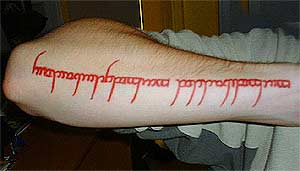
You may be wondering why BME is running an article on linguistics that barely mentions tattoos. Well, since BME was started in 1994 I’ve been getting photos of tattoos in the Elvish languages invented by JRR Tolkein, and my own now ancient first professionally done tattoo was in Quenya script. Now, with the overwhelming success of the movies, coupled with the stars of the films almost all going out and getting Tengwar tattoos themselves, we thought it might be fun to learn a little more.– ShannonElvish Spoken Here
by Frederick G. Volpicelli, CCPIn 1931, Tolkien wrote an essay about the somewhat peculiar hobby of devising private languages. He called it “A Secret Vice”. But in Tolkien’s case, the “vice” can hardly be called secret anymore.
What, really, is going on inside the head of a man who all his life is toying with enormous linguistic constructions, entire languages that have never existed outside his own notes? One thing that was important to Tolkien was that languages should be beautiful. Their sound should be pleasing. Tolkien tasted languages, and his taste was finely tuned. Latin, Spanish and Gothic were pleasing. Greek was great. Italian was wonderful. But French, often hailed as a beautiful language, gave him little pleasure, but heaven itself was called Welsh.
He stated that the Elvish tongues were “intended to be definitely of a European kind in style and structure and to be specially pleasant.”
While World War I was still raging, Tolkien’s linguistic constructions definitely became elvish languages. In 1916 he wrote that he had been working on his “nonsense fairy language — to its improvement. I often long to work at it and don’t let myself ’cause though I love it so it does seem such a mad hobby!” Mad or not, he was to give in to his longing and keep working on this hobby throughout his life.
Exactly at this point, in 1916, while Tolkien was in the hospital having survived the Battle of Somme, the very first parts of his “mythology for England” were written — fragments of what would one day become the Silmarillion. At the same time, he wrote his first Elvish word-lists. One thing triggered the other: “The making of language and mythology are related functions,” he observed in A Secret Vice. “Your language construction will breed a mythology” Or again in a letter written many years later, shortly after the publication of Lord of the Rings: “The invention of languages is the foundation. The ‘stories’ were made rather to provide a world for the languages than the reverse. To me a name comes first and the story follows. Lord of the Rings is to me…largely an essay in ‘linguistic aesthetic’, as I sometimes say to people who ask me ‘what is it all about?’” Few people took this explanation seriously. “Nobody believes me when I say that my long book is an attempt to create a world in which a form of language agreeable to my personal aesthetic might seem real,” Tolkien complained. “But it is true.”
The years passed by and the stories of the Silmarillion evolved, but it seems that the relevance of the original dictionaries soon dwindled: Frequent revisions inevitably rendered them obsolete. In the second half of the thirties, however, Tolkien made a list of some seven hundred Primitive Elvish “stems” and some of their derivatives in later languages. It was apparently this list, the so-called Etymologies, he was referring to when he started to write The Lord of the Rings.
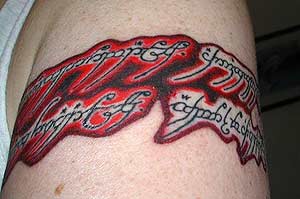
This brings us over to the technique used by Tolkien in devising his linguistic creations. How was it done? Christopher Tolkien, his son, describes his father’s strategy as a language-maker in one formidable sentence: “He did not, after all, ‘invent’ new words and names arbitrarily: in principle, he devised from within the historical structure, proceeding from the ‘bases’ or primitive stems, adding suffix or prefix or forming compounds, deciding (or, as he would have said, ‘finding out’) when the word came into the language, following it through the regular changes in form that it would thus have undergone, and observing the possibilities of formal or semantic influence from other words in the course of its history.” The result: “Such a word would then exist for him, and he would know it.”
Throughout his life he kept revising, revising, revising. In the words of his son, “The linguistic histories were…invented by an inventor, who was free to change these histories as he was free to change the story of the world in which they took place, and he did so abundantly… Moreover, the alterations in the history were not confined to features of ‘interior’ linguistic development: the ‘exterior’ conception of the languages and their relations underwent change, even profound change.”
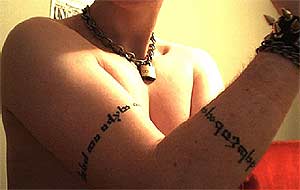
Sindarin is a good example of changed ideas about the outer history of the languages. The scenario set out in the appendices to Lord of the Rings is that this is the language of the Sindar, the Grey-elves — the Elves that came to Beleriand from Cuiviénen, but did not go over the sea to Valinor. But in Tolkien’s pre-Lord of the Rings notes, Sindarin is called Noldorin, and before that Gnomish, for this was the language of the Noldor or “Gnomes”, the “Wise Elves”. It was developed in Valinor, while Quenya in the former scenario was the language of the Lindar, the first of the three clans of the Eldar (to complicate matters even further, the Lindar were later renamed and became the Vanyar, while Lindar became a name of the third clan, the Teleri). But then Tolkien must have realized that the Elves, immortal and all, would hardly develop radically different languages when they lived side by side in Valinor. So according to the revised scenario, both the Vanyar and the Noldor spoke Quenya with just minor dialectal differences, while the “Noldorin” language that Tolkien had already made was simply re-christened Sindarin, transferred from Valinor to Middle-earth and relocated to the mouths of the Grey-elves there. It was, of course, far more plausible that they had developed a language very different from Quenya, having been separated from their kin in Valinor for thousands of years. Christopher Tolkien comments, “So far-reaching was this reformation that the pre-existent linguistic structures themselves were moved into new historical relations and given new names”. The various “flavors” of Elvish in body face above will later connect directly to various writing styles Tolkien invented. It is interesting to note that as he invented these languages and allowed them to age and morph together he continually left the original constructs alone. His language, therefore, has dialects spanning hundreds of years.
How, then, do Tolkien’s languages fare today, when a quarter of a century has passed? Some of us have embarked on the study of Elvish, perhaps with somewhat the same attitude as people enjoying a well-made crossword puzzle: The very fact that no real Elvish grammars written by Tolkien have been published makes it a fascinating challenge to “break the code”. Many simply enjoy the Elvish languages as one might enjoy music, as elaborate and (according to the taste of many) gloriously successful experiments in euphony. During my 40-year study I never actually tried to pronounce Elvish. It wasn’t until the movies were released that the music of Tolkien’s language came through for me. For those of you who are interested you can find an online Elvish Pronunciation Guide [dcs.ed.ac.uk].
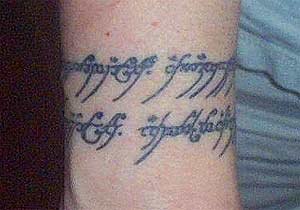
My own story started 40 years ago. I personally made a serious study of Elvish from 1964-1968 while attending the Courant Institute of Mathematical Sciences at New York University. It was a very complex game that allowed me to get lost in the Appendices of Lord of the Rings while surviving Calculus and Physics. In 1966 I switched from pure math to the then very new study of computers and proceeded to absorb my first computer language, Fortran II. Quickly added was Fortran IV (later to morph into Fortran 77 with BASIC as a subset), COBOL, SNOBOL, ALGOL, LISP, PL/1, and, of course, the very elemental assembly language (first for the Control Data 6600 mainframe, then 6502 processors). I don’t think I realized it then, but the study of elvish constructs prepared me for my initial forays into computer language. Tolkien’s language was perfectly created, few holes, strict rules, and logically bound. Just like computer languages (which didn’t exist when Tolkien invented Elvish).
To further my ability to deal with Elvish I took a college course in phonetics. (My NYU advisor had fits with me. I was a math major, taking a minor in English Literature, with Greek and Roman mythology, art history, and phonetics as electives). With a solid background in phonetics I was able to transcribe English into Elvish. You first break down the English into pure phonetic constructs. There is a whole separate compendium of characters to describe how words are actually pronounced (far past what’s in the dictionary). The beauty of phonetics is that the same constructs apply basically to all languages. Tolkien used these sale constructs to build his elvish language. There are direct correlations between the constructs and the written elvish letters.
So with a lot of study I was able to convert words into elvish script. Now back then, of course, it was all done by hand and mind. A long tedious process. I used to hand letter custom t-shirts for people as a way to pay the bills (somewhere along the way I took up the study of calligraphy). Fueled with copious amounts of drugs I got through college, picked up a Master’s degree in Computer Science, and started teaching. I was a High school math teacher, Assistant Professor of Computer Science, Visiting Lecturer, and now a network and Internet consultant. Along this 35-year odyssey, computers developed, and fonts came into being (it may not seem so, but True Type computer fonts are a very recent development).
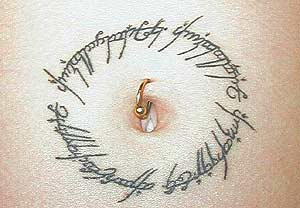
Turns out that there a lot of other fanatics like myself out there! Computer tools have been developed to transcribe the root English to phonetic constructs. True Type Elvish Fonts are developed. Photoshop provides the art space. Now I can transcribe rather quickly. Late last year, with the movies being so popular, I offered BME members a free transcription of anything they want. I create a hi-res JPG in one of the many elvish fonts available.
The artical title at the top of the page, “ELVISH SPOKEN HERE,” is transcribed just above it into the Tengwar cursive form of Elvish. The intermediate phonetic construct is written “jRrdT 8qzY5$ 96RO”. The construct is then converted to the correct Elvish font. The form of Elvish as created by Tolkein is known as Tengwar. This is a family of written languages belonging to the elves. The common style is called Sindarin and is the language of the Grey-Elves (i.e. Rivendell), another style is Quenya belonging to the “High-Elves”. There are numerous written variations, with some in the cursive style above and some in a more Runic style (as is the Cirth language of the Dwarves).
Frederick G. Volpicelli, CCP
What follows is the phrase “Elvish Spoken Here” transcribed into Tengwar in different styles.
Sindarin
Basic
Sindarin
Type 1
Sindarin
Type 2
Sindarin
Cursive
Quenya
Basic
Quenya
Type 1
Quenya
Type 2
Noldor
Basic
Noldor
Type 1
Noldor
Type 2
Note: The Tolkien backstory detailed above is largely paraphrased from articles at the Elvish Linguistic Fellowship, the Tolkien Society, and the introduction to “Tolkien’s Not-So-Secret Vice” by Helge Kåre Fauskanger.
Free for IAM Members: Elvish Transcription Service. Send me the text you want transcribed into one of many styles of Elvish and I’ll email you an image.Details can be found at www.mikron.com/bme/
Frederick G. Volpicelli (iam:misterV)
Article by Frederick G. Volpicelli. Copyright © 2004 BMEzine.com LLC. Permission is granted to reprint this article in its entirety as long as credit is retained and usage is non-commercial. Requests to publish edited or shortened versions must be confirmed in writing. For bibliographical purposes this article was first published March 25th, 2004 by BMEzine.com LLC in Toronto, Ontario, Canada.

-
Bill Heath: American Traitor [The Publisher’s Ring]
Written by

Bill Heath: American Traitor
“The only freedom which deserves the name, is that of pursuing our own good in our own way, so long as we do not attempt to deprive others of theirs, or impede their efforts to obtain it.”– John Stuart Mill, “On Liberty” (1859)
Note: If you’re reading this “live” as this incident is playing out, you can visit the website of The Piercing Experience, a Georgia studio (and one of the nation’s best) that is actively following this case and posting to-the-minute info.
Thanks to Republican representative Bill Heath, a man who many believe had part of his penis mutilated in a bizarre religious ritual*, Georgia (as in the US state, not the communist republic bordering Turkey) is getting ready to pass a new law banning genital piercing for consenting adult women. This law would dictate mandatory two year prison sentences for any piercer that does these piercings, with a maximum punishment of twenty years in state prison simply for doing a hood piercing. Shockingly, this law unanimously passed the House (160-0!) and is now seeking approval from the Senate before being signed by the Governor.
* It’s called circumcision, silly… but you have to admit that chopping off a part of a baby’s penis to appease your God is a little more messed up than adult women enjoying sex.Bill Heath sponsored the law as an amendment to an existing FGM bill, slipping it into an unrelated bill at the last moment after someone mentioned to him that female genital piercing existed — “What?” the moron replied (“slack-jawed” were the words of the Associated Press reporter). He continued, “I’ve never seen such a thing… I, uh, I wouldn’t approve of anyone doing it. I don’t think that’s an appropriate thing to be doing.” Later, after jotting down a quick anti-woman, anti-freedom rant, he explained, “[I am trying to] make illegal the voluntary piercing of female genitals for decorative purposes.”
This bill is fundamentally wrong. Honestly, it’s so wrong it’s insane. You know, I’ve seen politicians do some stupid things, but I’m still always amazed when someone’s hatred and closed-mindedness can so void any semblance of intelligence and leave them as nothing more than a hollering buffoon. Let’s take a closer look.
There has been no public or private debate on the subject.
Bill Heath wasn’t elected to introduce this ban — he’s not acting on his constituent’s wishes. He introduced it on a whim, after hearing about a subject he knew nothing about. I’ll ignore spending much time asking you whether you really want a politician that rashly forces through law, without consulting experts, the public, or anything other than his bigotry. Even if you agree with his conclusion about female genital piercing, his way of reaching and enacting it spits in the face of liberty.
The House never debated this amendment, and neither did the public — this was forced through so quickly that the media didn’t even report on it until the House had already approved the law. That’s just not how democracy is supposed to work!
This bill is fundamentally sexist and anti-woman.
A bill that bans a unisex activity (since both genders enjoy genital piercings) for only women is sexist. Remember, this bill only bans genital piercings on women — men are still permitted to have them. Saying that women can’t have piercings says that women don’t have a right to their bodies, since every woman I know with genital piercings got them consensually, and usually totally independently of anyone else. The supplemental argument — one that’s currently playing out in the California courts with Todd Bertrang — is that women are so weak that they can’t stop piercers forcing modifications on them, an equally insulting claim.
I don’t know if Bill Heath has fundamental shortcomings in his manhood that make him so terrified of female sexuality that he’s trying to ban it at all costs, but it’s not his place and it’s not his right. Especially given how many women use genital piercings as a way of claiming their own bodies back from male-dominated culture, Bill Heath’s attempt to violate women by taking away that right to their bodies is despicable. His attempt to introduce such legislation via a rider on a bill essentially designed to protect women makes it even more sickening…
This bill ignores thirty years of culture and research.
Genital piercing has been popular and at least partially above-board in Georgia for about thirty years, and publicly accessible commercial body piercing studios have been doing genital piercings for a decade and a half in Georgia. Tens of thousands of women in Georgia have genital piercings and are very happy with them, and complications are virtually unheard of (it’s not as if this is tongue splitting, or a procedure with real risks). There have been no studies suggesting that female genital piercings are anything except healthy, stimulating, and extremely positive.
This bill is unfair to business.
This bill tells companies with a decade and a half of successful and appreciated history in the community that, without space for debate or negotiation, they have to cease operating or face prison time. Government has no right to arbitrarily put people out of businesses they’ve held for most of their lives simply because some small-minded legislator decides to scribe his hate-filled whims onto a larger bill.
This bill violates citizen’s privacy and overextends government’s reach.
The simple fact is that this is none of the government’s business. We’re not talking about minors. We’re not talking about danger. We’re talking about a safe, positive, and private activity between consenting adults. This isn’t like drugs or guns or any of the other hot topics politically — there are no societal risks or dangerous cultural side-effects from allowing people to have happy lives. The government simply has no right to intrude on people’s private lives and tell them how to enjoy and decorate their genitals.
This bill does nothing to protect the safety of the public. It is nothing more than an attempt to enforce one specific moral code, and, even if Bill Heath is right and women with genital piercings are an affront to God, it’s not government’s place to write laws about it. Henry George said it far better than I could — “It is not the business of government to make men virtuous or religious, or to preserve the fool from the consequences of his own folly. Government should be repressive no further than is necessary to secure liberty by protecting the equal rights of each from aggression on the part of others, and the moment governmental prohibitions extend beyond this line they are in danger of defeating the very ends they are intended to serve.”
This bill is fundamentally unamerican.
This bill takes the shockingly backwards view of a tiny minority and attempts to force it on the majority. America, at least in theory, is a place where you can be whoever you want to be and do whatever you want to do, as long as you’re not hurting anyone else. Your own thing in your own time. America isn’t a country that passes laws putting people in prison for having the wrong political views. It’s not a country that tells people what they have to believe. It’s not a country that would send people to prison over body piercings for longer than they’d get for most armed robberies… or is it quickly becoming that, thanks to traitors like Bill Heath?
In the words of Thomas Jefferson, “I would rather be exposed to the inconveniences attending too much liberty than to those attending too small a degree of it.”
So let’s be real clear on this:
Bill Heath isn’t just a moron and a bigot. He’s also a traitor.Bill Heath is involved in an active conspiracy to strip American citizens of their fundamental civil rights and freedoms. Mask it in moralism all you want, but you can’t get rid of that core truth. Even if you think female genital piercing is sick and perverted, are you comfortable living in a country where the government is so controlling and invasive that they even tell you how to have sex?
Bill Heath thinks that’s what America should become. You can reach the treasonous bastard via email at [email protected] or via his homepage at billheath.net. In addition, here are three more direct methods:
HOME OFFICE CHURCH
2225 Cashtown Road
Bremen, Geogia 30110
770-537-5234
770-537-6383 (fax)(his wife Susan will answer — she probably does not have genital piercings)
Suite 501, Legislative Office Building
18 Capitol Square
Atlanta, Georgia 30334
404-656-0177(his secretary Pat Alexander will probably answer — chance of genital piercings also extremely low)
Abilene Baptist Church3917 Washington Road
Martinez, GA 30907
706-869-1774Be sure to let him know what you think — in the form of words though, not the bullets he deserves. Or, if you think you can contain your rage better than me and you think you can get through, try and explain to him or his wife why genital piercing is important to you and why you hope he’ll recant his crimes against humanity.

Shannon Larratt
BMEzine.comPS. You can also contact Governor Sonny Perdue himself at 404-656-1776 or online by clicking here. In addition, here’s a list of all the email addresses for Georgia’s Senators (who have to sign off on the bill next, although since it’s obvious that this ludicrous law would never stand up to a challenge in court, I’m hoping they’ll have the sense to remove it) — you can paste list this into your email and urge them to vote to remove Bill Heath’s anti-piercing amendment to House Bill 1477 (Senate Bill 418):
[email protected], [email protected], [email protected], [email protected], [email protected], [email protected], [email protected], [email protected], [email protected], [email protected], [email protected], [email protected], [email protected], [email protected], [email protected], [email protected], [email protected], [email protected], [email protected], [email protected], [email protected], [email protected], [email protected], [email protected], [email protected], [email protected], [email protected], [email protected], [email protected], [email protected], [email protected], [email protected], [email protected], [email protected], [email protected], [email protected], [email protected], [email protected], [email protected], [email protected], [email protected], [email protected], [email protected], [email protected], [email protected], [email protected], [email protected], [email protected], [email protected], [email protected], [email protected], [email protected], [email protected], [email protected], [email protected], [email protected]
-
Dick Zigun Interview – Through the Modified Looking Glass
Written by

NOTE: If you’re reading this on Wednesday, March 17th, then you can
watch The Lizardman on TechTV tonight when he’s the guest on UNSCREWED!
Dick Zigun
“Whatever you do, do it with all your might. Work at it, early and late, in season and out of season, not leaving a stone unturned, and never deferring for a single hour that which can be done just as well now.”
– P.T. Barnum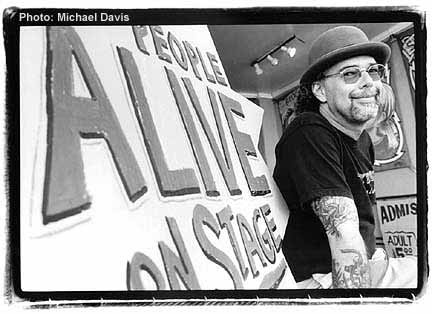
Dick Zigun is the man. No, not that man, not the one that’s been holding you down all these years. He’s the good kind. Dick is the driving, some might say whip-cracking, force that helps keeps sideshow alive at Coney Island. He is an ever present icon at Sideshows by the Seashore overseeing daily operations and even taking part in the cast when needed as a talker. If you’ve caught any of the many sideshow documentaries and programs that have often graced basic cable networks such as Discovery and TLC in the last half dozen years then you have likely seen Dick acting as spokesman for Coney Island — and he is eminently qualified to do so.
I first met Dick Zigun when I did a guest appearance at Coney Island in 2002. And, at the risk of tarnishing his otherwise gruff reputation, I have to say that what impressed me most was how incredibly welcome he made me feel. Talking with Dick and working with his cast, I had never before felt so good and reassured about myself and the path I had chosen.
But, I don’t want to risk ruining his reputation any further, so let’s meet Dick Zigun!
THE LIZARDMAN: Beginning with the usual interview formalities…DICK ZIGUN: I am founder and Artistic Director of Coney Island, USA, a non-profit arts organization dating from 1980 whose purpose “is to defend the honor of American popular culture through innovative performances and exhibitions.”I was born May 11, 1953 in Bridgeport, CT. PT Barnum was mayor, developer, and patron saint of Bridgeport. He built his houses there and had the winter headquarters of the circus there. He bought up the shorefront (which was the front yard of his second house) and left that property and others to the city for parks. There is a big beach with a statue of Barnum. To grow up in Bridgeport is to think that elephants and midgets are patriotic and all-American.
During the big Barnum Festival each summer (month long, largest 4th of July parade in USA during the 1950’s, car show, air show, 5th graders impersonating midgets, etc.) the local paper is full of biographical info on Barnum and Tom Thumb, who was born and lived a few doors from my grammar school. I was a Barnum scholar before I was a teenager.
THE LIZARDMAN: You have an impressive pedigree academically and professionally (Bennington, Yale) and many notable connections in the art world — so why sideshow?DICK ZIGUN: 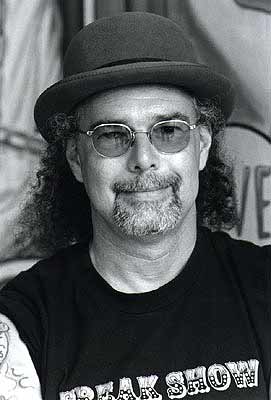
I was a scholarship student for a BA at Bennington College (when it was the most expensive college in the world in the early 70’s) and again a scholarship student for the 3 year MFA program at Yale School of Drama. Back then there were no books and no classes on sideshows or vaudeville or burlesque… not at my schools and not at any schools.As a Bridgeport guy out to defend American theatrical traditions I was an oddball, a rebel, and a pioneer. I was writing plays about ventriloquists wanting to kill Thomas Edison — things like that. Right out of Yale School of Drama I was produced in the regional theater movement I had been trained for but not happy typecast as an edgy experimental playwright doomed forever to producing new plays in regional theater second spaces for the hoity-toity blue haired ladies.
In 1979 I was having a play produced at the Mark Taper Forum in LA… grooving on the beach and thinking that LA was the capital of America… but set on living in New York City which is the capital of the world and the only place someone serious about theater can earn a living. Another play being produced at the same time in LA was KID TWIST by Len Jenkin about the Murder Inc. stool pigeon thrown out the hotel window in Coney Island. I went back again and again to see the play and Coney Island intellectually struck me as a way to live the beach lifestyle in NYC.
Then I was visiting the Santa Monica pier and epiphany struck when I saw an arcade building for rent. I vowed to go back to Coney Island and check out loft space. One thing lead to another and by 1985 I opened a theater/arts center on the Boardwalk called Sideshows by the Seashore. Sideshows are the most indigenous theatrical tradition in my chosen neighborhood so it was only natural to create a program where we would be the only place left in America to keep alive the ten-in-one.
THE LIZARDMAN: You are noticeably tattooed (your sleeves) with work by notable artists – tell us about your tattoo work and the artists responsible.DICK ZIGUN: Running an arts center has given me the opportunity to bring a lot of American underground culture into the mainstream by virtue of being a known arts center in NYC that sends out press releases, puts on public advertised shows, and organizes artists to present things. We not only pioneered the new sideshow movement but also helped to create the new burlesque movement, and within NYC (which tattooing was illegal in and no one was producing an annual tattoo show) helped to bring tattoos out of the underground.Our first tattoo/motorcycle show was in 1986. I was producing a tattoo show, hanging out with tattooed people, making money off of tattooed people, and was good friends with Michael Wilson… I thought long and hard for ten years about myself and whether I would spend my life employing freaky people but remaining a standoffish academic type. So in 1996, after ten years of over-intellectualizing, I came up with this: four limbs equals: earth, water, fire, air.
I got my first tattoo, on stage, in the street, in front of the police captain when tattooing was still illegal in NYC and everyone could hear me scream. Spider Webb tattooed my right arm which is “water”. Camille Cline, spider’s protégé, did my left arm which is air. Dragonfly, another spider protégé, is working on my right leg which is fire. That’s as far as I’ve gotten.
THE LIZARDMAN: At what point did you begin getting tattooed in relation to your association with sideshow?DICK ZIGUN: Michael Wilson, with his debut in Modern Primitives, had a lot to do with introducing post-modern tattoos and piercings to America. When Michael first worked here no one since Jack Dracula had publicly exhibited a tattoo face… some 20-25 years. It was a big deal and since pierced tongues were also unusual in the 1980’s it was a big deal when Michael would hammer a nail thru his tongue. Now every suburban teenage girl in American has a pierced tongue.When I first came to Coney Island I was an outsider artist type and my education and non-Brooklyn accent enamored me to the locals as a spokesman for Coney. It would have been difficult back then if I was heavily tattooed but now I’ve become some kind of Coney Island institution and as long as I stay alive and articulate it doesn’t matter much what I do… well, maybe it would matter if I tattooed my face.
THE LIZARDMAN: You have known and worked with a number of people who were heavily tattooed (including probably more facially tattooed modern performers than anyone else). Has this changed your perception of tattooing, or facial tattooing? Ever considered going that route yourself?DICK ZIGUN: Knowing and loving and respecting so many heavily tattooed people helped me accept the idea of inking myself. I can see myself with a total bodysuit but not facial or hand tattoos. I am an old-style kind of guy. My job is to be the producer and director and spokesman. I am not one of the performers. Since I am always hanging around the place my tattooed sleeves help in that I am another freaky looking staff person. But as a spokesman it is best that the audience more or less identify with me as one of them and not one of the extreme freaks.THE LIZARDMAN: Do you think that sideshow has helped or hindered the popular view of heavily modified people (such as those with facial tattooing)?DICK ZIGUN: Without question the sideshow movement has helped the popular view of heavily modified people. A few decades ago a Michael Wilson or Lizardman or Enigma would have been stoned walking down the average small town American street… now you all are famous TV celebrities.THE LIZARDMAN: What societal role do you see sideshow playing in the future? What does it provide?DICK ZIGUN: Sideshows have reintegrated themselves into American culture. You see sideshow influence in rock videos, in advertising, in fashion. I am proud to have a role in moving sideshow culture from the margins back into the mainstream, where it belongs. America used to have an inferiority complex about its own culture: sideshows, burlesque, vaudeville.We used to be embarrassed not proud of our populist culture. Everything used to be Eurocentric and that was boring and elitist. Artists especially are now free to use American culture as history and influence without freaking out their professors or getting kicked out of school, galleries, and museums. Nevertheless, not I nor Jim Rose nor the Bindlestiffs have made big money out of producing sideshows. It only goes so far.
I’d like to see it go farther and I’d like to see sideshows make more money — especially since we need to institutionalize the arts center in Coney Island, now that Coney Island is developing fast and taking off. We are renters and not owners and our lease in up in two years. We need to fund this place and the history that has taken place here since the 1980’s or else we will lose it.
THE LIZARDMAN: Coney Island now offers a sideshow school — tell us about that.DICK ZIGUN: Of course there is a lot of interest in sideshow acts by a new generation of circus idiots for the 21st century… and there is a lot of bad info out there in books and on websites about how to learn and master the sideshow arts which are dangerous!!! So since we are a non-profit educational institution we decided we would be the very first school which taught the arts the right way.It helps us earn money for our programs and it helps eager sideshow amateurs learn how to stay out of the hospital.
THE LIZARDMAN: With over two decades experience you have been working the sideshow longer than many of its current fans and hopeful future stars have been alive. What would you suggest they consider or do before taking their first steps or preparatory measures before beginning training at the school or elsewhere?DICK ZIGUN: I am amazed how casually some people tattoo their faces or do extreme body modification these days. Used to be that someone would get a tattooed bodysuit first and then consider the face but these days some kids start with the face.Frankly, although a lot of brilliant committed people get facial tattoos, a lot of others are “no future” crusty heroin junky types who just don’t care about next year or even what tomorrow brings. Fine if that’s your chosen lifestyle, fine but sad… but if you’re gonna be a professional in a sideshow then you need to show up for work on time every day and act sober — junkies don’t get jobs on payroll at Sideshows by the Seashore.
THE LIZARDMAN: Given your experiences would you recommend others attempt a similar path?DICK ZIGUN: If it is a “labor of love” and you just gotta do it, then sure, I’ll not only recommend it but be your mentor and give you advice (up to a point; don’t need more competitors). Ain’t no one gonna get rich doing sideshows and the trials and tribulations will mess with your family life and love life and make your life hard but very, very interesting.THE LIZARDMAN: What does the word ‘freak’ mean to you?DICK ZIGUN: Freak used to be a pejorative, a bad word. Now it’s a badge of honor. People wanna be a freak. Freaks have freedom; freaks are not like everyone else. Freaks are cool.THE LIZARDMAN: Is there any act that you have always wanted for the show but never got?DICK ZIGUN: Siamese Twins. A perfectly proportioned 3 foot high midget. A 9 foot tall giant. The real missing link. Hell, even a sideshow celeb like the Lizardman working for me at minimum wage for an entire summer. I better keep dreaming…THE LIZARDMAN: Say whatever you want.DICK ZIGUN:
 Erik Sprague
Erik Sprague
because the world NEEDS freaks…
Former doctoral candidate and philosophy degree holder Erik Sprague, the Lizardman (iam), is known around the world for his amazing transformation from man to lizard as well as his modern sideshow performance art. Need I say more?
Copyright © 2004 BMEzine.com LLC. Requests to republish must be confirmed in writing. For bibliographical purposes this article was first published March 17th, 2004 by BMEzine.com LLC in Toronto, Ontario, Canada.
-
Who Was Doug Malloy? [Running The Gauntlet – By Jim Ward]
Written by


Who Was
Doug Malloy?
part one
Doug Malloy was what an acquaintance of mine called the “nom de kinque” of a wealthy Hollywood businessman named Richard Simonton. I was given to understand that Malloy was his mother’s maiden name. Being an Irish name, I can’t help thinking one of his forebears must have kissed the Blarney stone, for Doug had a remarkable flair for telling a story, and if it wasn’t exactly true, it didn’t particularly matter to him as long as the tale was a good one. Consequently I can’t guarantee the accuracy of everything that Doug told me about himself or about the history of piercing for that matter. But he told wonderful stories, and the fact that many of them persist despite a lack of any supporting evidence says much for his ability to capture our imaginations.
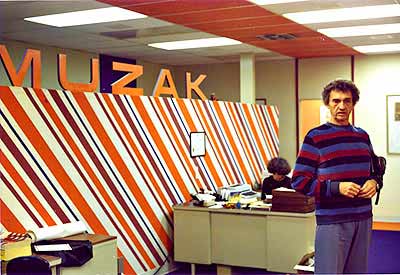
Doug in the Muzak offices in Hollywood.
I know little about his youth. From an early interview it appears he was born in Chicago and his family moved to the Seattle area when he was about three. By the time the Depression hit in 1929, he would have been in his early teens. I gathered the family wasn’t exactly affluent. Eventually he ended up in Southern California and his fortunes began to change. In the early 40s he struck a lucrative deal with Muzak, the ubiquitous background music company, which gave him control over the southwestern quarter of the country. It made him a very rich man.
Doug was quite interested in things metaphysical. He had been a personal friend of Ernest Holmes (1887–1960) author of The Science of Mind and the founder of the Religious Science movement. Thanks in no small part to Holmes’ influence, he was very much a believer in what became known as the “power of positive thinking.”
He also believed in reincarnation. According to Doug it explained not only things like prodigies, but also why some people became passionate about things like body piercing. This, he claimed, was his own case. He remembered a past life during which he had been a highly placed courtier in the entourage of Egyptian pharaoh Akhenaton.
Supposedly navel piercing was common amongst the aristocracy but forbidden to the lower classes. Doug claimed that the piercing could be seen in statuary, but try as I might I was unable to see it in the photos which he showed me. Within the last 50 years scientists have been able to construct an extremely clear and accurate picture of Egyptian life dating back several thousand years. To date I am unaware of any evidence having been discovered that would substantiate Doug’s claim.
Meanwhile back in ancient Egypt, Doug’s ancient self had a jealous rival at court who arranged to have him murdered. This left a karmic debt that the rival was attempting to repay in Doug’s present incarnation. From time to time the “Little Man” as he was called would appear and offer Doug advice and occasionally make predictions. I know of at least one that wasn’t accurate. Doug was told he’d live to the year 2000. Maybe by some antiquated calendar. At least by our calendar he was off by nearly 25 years.

Doug walking in his back yard at the edge of Toluca Lake.
Doug had an incredible home in the San Fernando Valley. Allegedly he had been told psychically to start construction on it even before he’d amassed the fortune necessary to complete it. It was in an area called Toluca Lake, named after the small body of water on the edge of which the house was being built. To the best of my knowledge there is no public access to the lake itself because it is completely surrounded by homes. Warner Brothers studio is a short distance to the East. Doug’s neighbors included Bob Hope, Olivia de Haviland, and Walt Disney’s brother Roy.

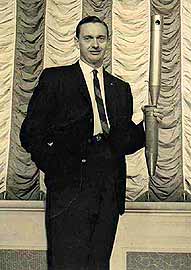
Left: Doug’s living room with its church-style organ,
Right: Doug, circa 1950, with a theater organ pipe in his hand.
From the street, the house itself was not particularly impressive. It appeared to be a modest, modern, one-level box. But inside it was a marvel. There was an atrium with a roof that could be retracted. The house had not one, but two pipe organs. One was a church-style organ in the living room. A narrow spiral staircase lead down to a small, 99-seat theater in which there was a fully restored Wurlitzer theater organ dating from the 1920’s. During the silent movie days it had graced a Paramount Studio sound stage. Doug’s interest in theater organs inspired him to found the American Theater Organ Society in 1955.

Doug in his theater projection booth.
The theater was equipped with state of the art projection and recording facilities. On several occasions a few other Tattoo & Piercing group members and I were invited to join some of Doug’s other friends for private showings in the theater.
Doug had been a very close friend of the comedy film star of silent movie fame, Harold Lloyd. When Harold died in 1971, Doug was the executor of his estate. This gave him access to all of Harold’s old films.
Another close friend was an old theater organist named Gaylord Carter. Quite naturally things came together for showings of several Harold Lloyd silent films accompanied live by Carter. These were truly once-in-a-lifetime experiences, and I’ll never forget them.
Doug’s interests were many and varied. In addition to organs, he had a passion for steamboats. In 1957 he and his family took a trip on the Mississippi riverboat the Delta Queen. On learning that the company was about to go under and this was to be its final season, Doug purchased controlling interest in the company in 1958. With his entrepreneurial skills he quickly turned it into a highly profitable enterprise.
I was not fortunate enough to have met Doug at the height of his prowess. A few years previously he had sustained brain damage from an event which nearly killed him. This had effected his ability to express himself. He confided in me that he had once been “an eloquent speaker” and was actually planing to pursue a political career when it all came to an abrupt end. The experience also forced him to take things easier and freed him to indulge his other great passion, body piercing.
During one of our many conversations Doug confided in me that had he been born at a later time he would probably have been gay. But he was born at a time when such a lifestyle could easily make anyone an outcast. He had ambitions, and he also believed that he and the members of his family had been together in a past incarnation. It was important that he provide the means for all of them to incarnate together once again.



Although not common today, Doug preferred to wear a large ring in his frenum piercing, sized to encircle his penis. He claimed that some men liked to sleep with their finger through the ring. Notice his Hafada.Right: Doug’s Guiche.
Shortly before we met, Doug had written a short autobiography of his piercing exploits entitled The Adventures of a Piercing Freak (click the link to read it). He had subsequently sold the article to a publisher of fetish magazines who issued it in soft cover under the title The Art of Pierced Penises and Decorative Tattoos. Since body piercing was virtually unknown at the time, the publisher was hard pressed to find suitable images to accompany the text. Consequently the photographs used had nothing to do with the story.
Piercing Freak could hardly be described as great literature. It is told in a bold style with a certain hyper-masculine bravado. Although I think it largely failed, it was clearly intended as “one-handed reading” for a primarily gay fetish market. Fantastic as parts of it are, Doug insisted the story was true. It’s difficult to believe it was commonplace for divers to use Prince Albert rings to attach an external catheter or that there was actually a college organization of Jewish men advocating Dydoe piercings to restore sensation for circumcised males.
Doug did author, to some extent, promotional material for Gauntlet and articles for Gauntlet’s magazine Piercing Fans International Quarterly. The truth is I was the ghostwriter for these working from notes that he provided. One of the first promotional pieces we did was a flyer entitled “Body & Genital Piercing in Brief” (click the link to read it). It contained short histories and descriptions of a dozen piercings Doug considered “traditional.” I drew the illustrations to accompany them. The piercings included were:
- Nipple
- Navel
- Prince Albert
- Dydoe
- Ampallang
- Apadravya
- Frenum
- Hafada
- Guiche
- Foreskin
- Labia
- Clitoris
Of particular interest is the fact that, with the exception of the navel, all of these piercings have a largely sexual purpose. This reflects Doug’s primary interest in body piercing as a means of enhancing erotic sensation.
The impact the “Piercing Brief” has had is phenomenal. It was widely distributed and reprinted and contained many of the colorful myths that persist and, to some extent have been widely accepted as fact. There has never been any proof to substantiate, among other things that:
- Roman Centurians wore nipple rings to which they attached short capes.
- Navel piercings were a sign of royalty in ancient Egypt.
- Beau Brummell and Prince Albert had their penises pierced.
- Arab boys had the side of their scrotums pierced at puberty.
- Male South Pacific islanders did the Guiche piercing.
The evidence on which Doug based his Roman Centurians claim was a Baroque statue he’d seen in Versailles. He showed me a photograph. I pointed out to him that Roman military men frequently wore metal breastplates sometimes sculpted to resemble a muscular male chest. The rings with cape attached were in the breastplate, not the man. Doug paused for a moment to ponder my observation, then replied, “Well, it makes a good story anyway.”
There are actually very few body piercings which have a documented history. The most extensively written about is the Ampallang, which at one time was fairly common in the areas surrounding the Indian Ocean. There is one sole reference to the Apadravya that I am aware of and it is in the Kama Sutra. Doug maintained that the Ampallang was horizontal through the head of the penis and the Apadravya vertical. Piercer and researcher Paul King of Cold Steel in San Francisco maintains that the piercings are in fact one and the same and that either one could be oriented in either direction. Whatever the facts, most piercing enthusiasts have accepted Doug’s designation.
Less extensively documented are foreskin piercings. We do know that they were performed as part of a procedure called infibulation. Usually it was done to male slaves as a means of enforcing chastity. Women with pierced labia can also be infibulated though the documentation of the procedure is scarce.
I sometimes wonder if people into piercing today have any deep appreciation of the tremendous impact Doug Malloy has had on their lives. Certainly he had predecessors and contemporaries equally as passionate about piercing as he, but what was it that made him the center from which the whole modern piercing movement sprang?

A happy Doug wearing an airbrushed T-shirt made for him by tattooist Cliff Raven. Over his right nipple are the letters DMMP which stood for “Doug Malloy, Master Piercer.” Over the left nipple is IIPPI. The letters stood for “If it protrudes, pierce it.”
I think there are several reasons. For one, no one before him had ever presented such a broad palette of piercing possibilities complete with history and lore. It didn’t matter that he probably made up a lot of it, if not the piercings themselves. He’d at least done enough experimentation on himself to have some sense of their feasibility. This made it possible for him to speak with a confidence that leant great credibility to what he said. It didn’t hurt that it was a message a lot of people were waiting to hear whether they realized it or not.
It was also fortunate that Doug didn’t pursue his passion completely in private. Although he was extremely secretive about it, particularly with his family and non-kinky friends, he nonetheless reached out to other piercing enthusiasts who would go on to spread his message.
Finally, regardless of how primitive they might have been, Doug had formulated some basic but usable piercing techniques that, for the most part, could be applied by anyone.
If you combine all these elements with his good fortune of being in the right place at the right time, you can begin to see the seed that would grow into the modern piercing movement and appreciate how Doug vastly enriched your life.
Next: Gauntlet’s Jewelry Design Legacy
Jim Ward is is one of the cofounders of body piercing as a public phenomena in his role both as owner of the original piercing studio Gauntlet and the original body modification magazine PFIQ, both long before BME staff had even entered highschool. He currently works as a designer in Calfornia where he lives with his partner. Copyright © 2004 BMEzine.com LLC. Requests to publish full, edited, or shortened versions must be confirmed in writing. For bibliographical purposes this article was first published March 15th, 2004 by BMEzine.com LLC in Toronto, Ontario, Canada

-
COINTELPRO Tactics and the Elimination of the Tattoo Menace [The Publisher’s Ring]
Written by

COINTELPRO Tactics and the
Elimination of the Tattoo Menace
“When truth is discovered by someone else, it loses something of its attractiveness.”
– Alexander SolzhenitsynSome people tell me that the problem with BME is that it’s very “us and them”. It’s true. There’s a strong separatist movement on BME, and when it comes down to it I don’t trust people without body modifications. I’ll even go one step further — I don’t believe that people without body modifications are really even fully birthed and evolved humans, because I believe that communication, expression, and self-improvement are core to what a human is, and I believe that body modification (in one form or another, including everything from body building to transhumanism) is the purest form of these traits.
There’s an old saying that the difference between people with tattoos and those without is that those with tattoos don’t care if you have tattoos or not. I’d like to expand on that by adding that the difference between people with tattoos and those with fake tattoos is that those with the fake tattoos are losers that are not only making themselves look like idiots, but make real tattooed people look bad as well.

A lot of people have been sending me links to the site above (www.sleevesclothing.com), a new business venture by the folks at Tinsley Transfers, a temporary tattoo company. Basically they’re flesh-tone shirt/stockings with high quality prints of large tattoos on them. Unlike fashions that simply co-opt tattoo designs (which I have no fundamental problem with, and think is flattering), the goal of these is to actually make it look like you have large-scale tattoos — it’s a costume. I’m certainly not doubting the quality of their product technically — it looks quite well made. However, when you’re talking about an “I’m an idiot” sign, quality really isn’t your core problem.
At it’s most basic, shirts like these show a fundamental lack of respect for people with tattoos. It’s basically stealing tattoo culture in a way that would be no better than stealing the religious icons of another faith and turning them into some sort of disposable pop culture reference (an ironic analogy given that this is one of the sins of the tattoo community in many people’s eyes).
To me the issue is in the conversion of a permanent message into a transient message (to say nothing of the elimination of the “message of the message” altogether) — the exchange of commitment and loyalty for transience and whoring. Most people with tattoo sleeves take them quite seriously. After all, they’re there for life! Sleeves shirts on the other hand can be taken off, discarded, and swapped for another one as easily as any t-shirt, and because of their “it’s better than a real tattoo” stance it’s a slap in the face of anyone with genuine tattoos. Not only are they being crass and ignorant, but people wearing these shirts are making the public statement that their definition of self is a deception (ie. “I am a lie; I am not what you see.”) — and that tattoos are a part of that lie.
The fact is, the type of expression you get from fashion is fundamentally different than the type of expression you get from tattoos. Tattoos say “not only do I believe in this message, but I AM become this message,” whereas images on a piece of clothing (or makeup) simply say “here’s the lie of the day” — at best they are decorations without meaning or value, part of an elaborate social bluffing game. Now, maybe you’re asking why I have to take this all so seriously, why does it matter if someone likes the way tattoos look but doesn’t want to actually have them? The reason it matters is because they are stealing and then damaging — the only reason they “look cool” is because of the hip cachet that we (the tattooed people) have created by the way we collectively lead our lives. They want to be us, but they don’t have the commitment to be us. It’s not so much that they don’t have a right to share that look, it’s more that they don’t have a right to destroy it through devaluation (as they take a permanent fashion and turn it into the
looklie of the month).In any case, these shirts are incredibly lame, and even if the fashion world loves them briefly, they’ll be spit out as the remnants of a now uncool trend a few months later… tagging all tattooed people with that brush as they fall — after all, if fake tattoos are passé, how lame are real tattoos?
Now, I promised you this was going to be about COINTELPRO tactics and the elimination of the tattoo menace. COINTELPRO was an FBI program between the 1950s and early 70s that sought to “neutralize political dissidents”. This included everyone from communists, socialists, and union activists to influential anti-war and pro-civil rights celebrities like Jane Fonda and John Lennon, the Black Panthers, the KKK, the Yippies, and so on. One of their most effective strategies, far more effective than assassination and more brutal suppression, was simply to discredit. Instead of killing the speaker, or logically debating their politics, they simply used media actions to paint them as buffoons (watch Steal This Movie for a decent fictionalized account how COINTELPRO eventually pushed Abbie Hoffman to “suicide”).
Being painted as buffoons is what these “Sleeves” shirts do, and it’s a growing media trend when it comes to the coverage of tattoos. Take a look through the BME newsfeed and you’ll regularly see articles on people regretting their tattoos (or other mods) and having to get them removed in shame. Here’s a sampling of headlines:
- Tattoos: Decoration or tacky?
- Tattoos that are not for life...
- Geri Halliwell removes old tattoo
- Americans Likelier Than Italians to Regret Decision to be Tattooed
- Doctor Removes Obsolete Tattoos
- Think before you ink: Tattoo removal on the rise
- Christina Aguilera removes most of her piercings
The casual mainstream reader gets the impression not that tattoos are dangerous or “underground” in some way, but instead that they’re simply a stupid mistake, and that people getting them regret it because tattoos are lame and become dated fast. Basically, the current media premise is that tattoos are for buffoons — prompting a friend of mine to make a sign for the door of his new tattoo studio reading “if you’re not a criminal or a drug addict, you’ve come to the wrong place.” In the past, tattooed people were frightening, but these days they’re simply pathetic and laughable… or so the media would have you believe.
In my last column I pointed out that the best way to get young people covered in tattoos is to tell them they’re dangerous, edgy, and underground. Conversely, the best way to get them away from tattoos is to try and trick them into thinking they’re lame and less meaningful than they actually are — and that’s why we need to worry when we start seeing these COINTELPRO-type tactics being used. Now, I’m not proposing that this is some grand conspiracy where some secret anti-tattoo illuminati is meeting to orchestrate this whole thing. The media is doing their normal coverage cycle where something goes from scary to cool to mainstream to lame to forgotten, and the fashion world is simply latching onto that to try and make a quick buck. But when it comes down to it, it’s the attack’s end result that we need to worry about as much as the motivation or lack thereof.
So how do we make this a non-issue?
I suppose the simple answer is that we need to put outlaw culture back into tattooing. So if you’ve got a tattoo, make sure you kick someone’s ass at least once a week — preferably while you’re rip-roarin’ drunk — and do at least a little prison time.
Seriously though, some people have suggested that it’s quite wonderful that the mainstream has gotten into tattooing with such gusto. In some ways I agree, and it’s been wonderful to watch so many human flowers bloom. Additionally, the mainstream attention has resulted in a lot of money flowing in this community and great things are happening because of it. But the mainstream is fickle and looking at even just the last forty years of Western history, it’s obvious that the mainstream’s sensibilities shift radically every decade or so… and we’re starting to approach the end of the “tattoo decade” in terms of mainstream acceptance. It’s possible that we’ve hit a threshold where there’s no going back (15% of Americans are tattooed), but we’re still a tiny minority when you look at it objectively, especially when you only consider those that are heavily or publicly tattooed.
Tattooing as expressed by Western culture is nearly unique historically in its level of variation. No other culture in history that we know of has allowed for this depth of personal expression (indigenous cultures usually used tattoos to emphasize social structures and offered little in the way of personal variance). Not only for our own good, but for the good of the human race, we must embrace this individuality and fight anything that tries to commodify it and make it mundane. Tattooing should be an expression of self; a carnal message rather than some banal false-individuality of a temporary mask. Maybe the truth of the matter is that most people simply don’t have anything to say (but desperately want to), so they are drawn to this “prepackaged mass-produced individuality” that mainstream tattooing (and fake tattooing) gravitates to. Maybe the mainstream drones can’t appreciate the meaning of tattooing, because they don’t have a meaning themselves?
Keep your tattoos real and believe in them. Get your tattoo, not someone else’s. Like the ancient gods, tattoos gain their power from faith, sacrifice, and belief. Tattoos are power sigils, personal magic that can help rocket a person to their full potential. They’re not buffoonery, and they’re most certainly not something you can take on and off like makeup or clothing.
The mainstream never got it, and they never will.

Shannon Larratt
BMEzine.comNext column: Applications of body modification in modern magick.
Photos of “Sleeves” clothing (including cover image) property of Tinsley Transfers Inc. (http://tinsleytransfers.com/), reproduced under fair use doctrine.

